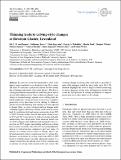Thinning leads to calving-style changes at Bowdoin Glacier, Greenland
Abstract
Ice mass loss from the Greenland ice sheet is the largest single contributor to sea level rise in the 21st century. The mass loss rate has accelerated in recent decades mainly due to thinning and retreat of its outlet glaciers. The diverse calving mechanisms responsible for tidewater glacier retreat are not fully understood yet. Since a tidewater glacier's sensitivity to external forcings depends on its calving style, detailed insight into calving processes is necessary to improve projections of ice sheet mass loss by calving. As tidewater glaciers are mostly thinning, their calving styles are expected to change. Here, we study calving behaviour changes under a thinning regime at Bowdoin Glacier, north-western Greenland, by combining field and remote-sensing data from 2015 to 2019. Previous studies showed that major calving events in 2015 and 2017 were driven by hydro-fracturing and melt-undercutting. New observations from uncrewed aerial vehicle (UAV) imagery and a GPS network installed at the calving front in 2019 suggest ungrounding and buoyant calving have recently occurred as they show (1) increasing tidal modulation of vertical motion compared to previous years, (2) absence of a surface crevasse prior to calving, and (3) uplift and horizontal surface compression prior to calving. Furthermore, an inventory of calving events from 2015 to 2019 based on satellite imagery provides additional support for a change towards buoyant calving since it shows an increasing occurrence of calving events outside of the melt season. The observed change in calving style could lead to a possible retreat of the terminus, which has been stable since 2013. We therefore highlight the need for high-resolution monitoring to detect changing calving styles and numerical models that cover the full spectrum of calving mechanisms to improve projections of ice sheet mass loss by calving.
Citation
van Dongen , E C H , Jouvet , G , Sugiyama , S , Podolskiy , E A , Funk , M , Benn , D I , Lindner , F , Bauder , A , Seguinot , J , Leinss , S & Walter , F 2021 , ' Thinning leads to calving-style changes at Bowdoin Glacier, Greenland ' , Cryosphere , vol. 15 , no. 2 , pp. 485-500 . https://doi.org/10.5194/tc-15-485-2021
Publication
Cryosphere
Status
Peer reviewed
ISSN
1994-0416Type
Journal article
Description
This research has been supported by the Alfred and Flora Spälti Fund and the ETH Zurich Foundation (Sun2ice; grant no. ETH-12 16-2); the Swiss National Science Foundation (grant nos. 200021-153179/1 and PP00P2_183719); the SPI Exploratory Grants 2018 awarded to Fabian Walter and Guillaume Jouvet; the Japanese Ministry of Education, Culture, Sports, Science and Technology through the GRENE Arctic Climate Research Project and the Arctic Challenge for Sustainability (ArCS) project; and by NERC (CALISMO: Calving Laws for Ice Sheet Models; grant no. NE/P011365/1).Collections
Items in the St Andrews Research Repository are protected by copyright, with all rights reserved, unless otherwise indicated.

